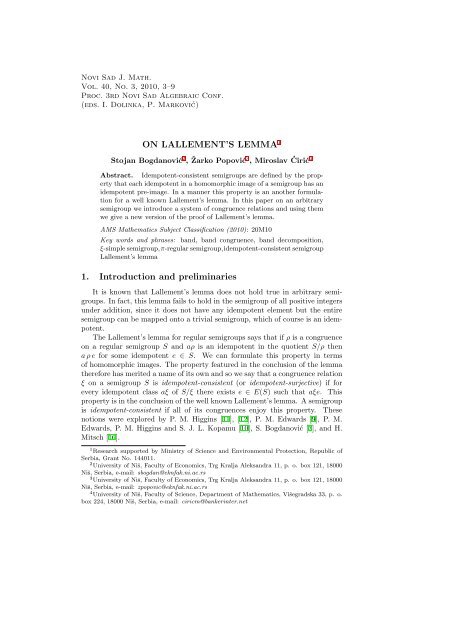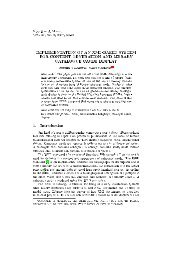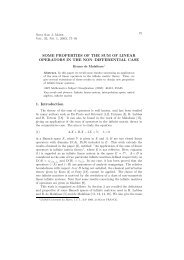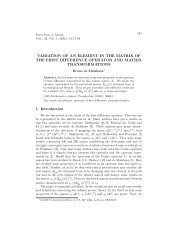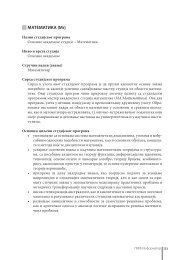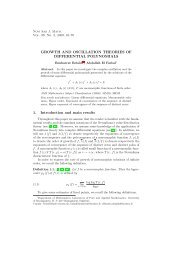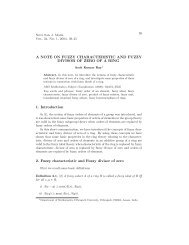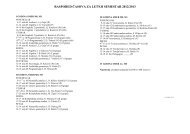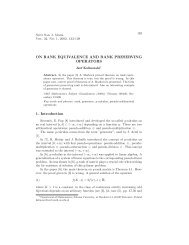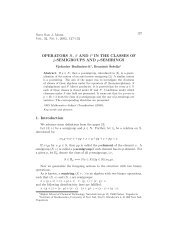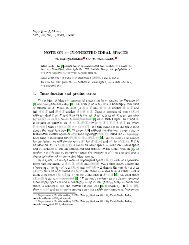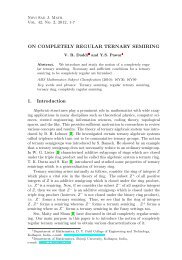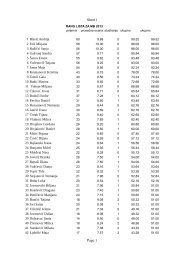Lallement's lemma
Lallement's lemma
Lallement's lemma
Create successful ePaper yourself
Turn your PDF publications into a flip-book with our unique Google optimized e-Paper software.
Novi Sad J. Math.<br />
Vol. 40, No. 3, 2010, 3–9<br />
Proc. 3rd Novi Sad Algebraic Conf.<br />
(eds. I. Dolinka, P. Marković)<br />
ON LALLEMENT’S LEMMA 1<br />
Stojan Bogdanović 2 , Žarko Popović 3 , Miroslav Ćirić 4<br />
Abstract. Idempotent-consistent semigroups are defined by the property<br />
that each idempotent in a homomorphic image of a semigroup has an<br />
idempotent pre-image. In a manner this property is an another formulation<br />
for a well known Lallement’s <strong>lemma</strong>. In this paper on an arbitrary<br />
semigroup we introduce a system of congruence relations and using them<br />
we give a new version of the proof of Lallement’s <strong>lemma</strong>.<br />
AMS Mathematics Subject Classification (2010): 20M10<br />
Key words and phrases: band, band congruence, band decomposition,<br />
ξ-simple semigroup,π-regular semigroup,idempotent-consistent semigroup<br />
Lallement’s <strong>lemma</strong><br />
1. Introduction and preliminaries<br />
It is known that Lallement’s <strong>lemma</strong> does not hold true in arbitrary semigroups.<br />
In fact, this <strong>lemma</strong> fails to hold in the semigroup of all positive integers<br />
under addition, since it does not have any idempotent element but the entire<br />
semigroup can be mapped onto a trivial semigroup, which of course is an idempotent.<br />
The Lallement’s <strong>lemma</strong> for regular semigroups says that if ρ is a congruence<br />
on a regular semigroup S and aρ is an idempotent in the quotient S/ρ then<br />
a ρ e for some idempotent e ∈ S. We can formulate this property in terms<br />
of homomorphic images. The property featured in the conclusion of the <strong>lemma</strong><br />
therefore has merited a name of its own and so we say that a congruence relation<br />
ξ on a semigroup S is idempotent-consistent (or idempotent-surjective) if for<br />
every idempotent class aξ of S/ξ there exists e ∈ E(S) such that aξe. This<br />
property is in the conclusion of the well known Lallement’s <strong>lemma</strong>. A semigroup<br />
is idempotent-consistent if all of its congruences enjoy this property. These<br />
notions were explored by P. M. Higgins [11], [12], P. M. Edwards [9], P. M.<br />
Edwards, P. M. Higgins and S. J. L. Kopamu [10], S. Bogdanović [3], and H.<br />
Mitsch [16].<br />
1 Research supported by Ministry of Science and Environmental Protection, Republic of<br />
Serbia, Grant No. 144011.<br />
2 University of Niš, Faculty of Economics, Trg Kralja Aleksandra 11, p. o. box 121, 18000<br />
Niš, Serbia, e-mail: sbogdan@eknfak.ni.ac.rs<br />
3 University of Niš, Faculty of Economics, Trg Kralja Aleksandra 11, p. o. box 121, 18000<br />
Niš, Serbia, e-mail: zpopovic@eknfak.ni.ac.rs<br />
4 University of Niš, Faculty of Science, Department of Mathematics, Višegradska 33, p. o.<br />
box 224, 18000 Niš, Serbia, e-mail: ciricm@bankerinter.net
4 Stojan Bogdanović, Žarko Popović, Miroslav Ćirić<br />
By Z + we denote the set of all positive integers. By S 1 we denote a semigroup<br />
S with identity 1. By E(S) we denote the set of all idempotents of a semigroup<br />
S. A semigroup which all its elements are idempotents is a band.<br />
The notion of regularity was introduced by J. von Neumann [18], and it<br />
play the important role in a ring and a semigroup theory. An element a of a<br />
semigroup S is regular if there exists x ∈ S such that a = axa. A semigroup S<br />
is regular if all its elements are regular.<br />
As a generalization of regularity R. Arens and I. Kaplansky in [1] were<br />
introduced the notion of π-regularity. An element a ∈ S is π-regular if there<br />
exists n ∈ Z + and x ∈ S such that a n = a n xa n . A semigroup S is π-regular if<br />
all its elements are π-regular, i.e. if some power of every its element is regular.<br />
The class of regular semigroups certainly does not exhaust the class of<br />
idempotent-consistent semigroups as it is a simple matter to check that every periodic<br />
semigroup, or more generally every (completely) π-regular, is idempotentconsistent.<br />
A generalization of Lallement’s <strong>lemma</strong> that includes all the cases<br />
mentioned so far was provided by P. M. Edwards [9], where it was shown that<br />
the class of idempotent-consistent semigroups includes all π-regular semigroups.<br />
For the related result see also [4].<br />
Although the class of π-regular semigroups does not contain all idempotentconsistent<br />
semigroups it was shown however in [17] by P. Murty, V. Ramana<br />
and K. Sudharani, that any idempotent-consistent and weakly commutative<br />
semigroup is also π-regular. A semigroup S is weakly commutative if for all<br />
a, b ∈ S there exists n ∈ Z + such that (ab) n ∈ bSa.<br />
The converse implication does not generally hold however in that not all<br />
idempotent-consistent semigroups are π-regular. This was first shown by S. J.<br />
L. Kopamu [15] through the introduction of the class of structurally regular<br />
semigroups which are defined using a special family of congruences. Some characterizations<br />
of semigroups, by congruences which are more general then ones<br />
introduced by S. J. L. Kopamu in [14], are considered by S. Bogdanović, Ž.<br />
Popović and M. Ćirić in [6] and [7]. S. J. L. Kopamu proved that Lallement’s<br />
<strong>lemma</strong> holds for the class of all structurally regular semigroups.<br />
Here, on an arbitrary semigroup, for m, n ∈ Z + , we define a family of congruence<br />
relations τ (m,n) and using them we prove: if the quotient semigroup<br />
S/τ (m,n) is π-regular, then a semigroup S is idempotent-consistent. This statement<br />
is one new version of Lallement’s <strong>lemma</strong>. Also, we describe the structure<br />
of semigroups in which the relation τ (m,n) is a band congruence. The results presented<br />
in this paper are generalizations of results obtained by above mentioned<br />
authors.<br />
Let ϱ be an arbitrary relation on a semigroup S. Then the radical R(ϱ) of<br />
ϱ is a relation on S defined by:<br />
(a, b) ∈ R(ϱ) ⇔ (∃p, q ∈ Z + ) (a p , b q ) ∈ ϱ.<br />
The radical R(ϱ) was introduced by L. N. Shevrin in [19].<br />
An equivalence relation ξ is a left (right) congruence if for all a, b ∈ S, a ξ b<br />
implies ca ξ cb (ac ξ bc). An equivalence ξ is a congruence if it is both left and
On Lallement’s <strong>lemma</strong> 5<br />
right congruence. A congruence relation ξ is a band congruence on S if S/ξ is<br />
a band, i.e. if a ξ a 2 , for all a ∈ S.<br />
Let ξ be an equivalence on a semigroup S. By ξ ♭ we define the largest<br />
congruence relation on S contained in ξ. It is well-known that<br />
ξ ♭ = {(a, b) ∈ S × S | (∀x, y ∈ S 1 ) (xay, xby) ∈ ξ}.<br />
Let k ∈ Z + be a fixed integer. On a semigroup S we define the following<br />
relation by<br />
(a, b) ∈ η k ⇔ a k = b k .<br />
It is easy to verify that η k is an equivalence relation on a semigroup S. This<br />
relation was introduced by S. Bogdanović, Ž. Popović and M. Ćirić in [7].<br />
For undefined notions and notations we refer [4], [5], [11] and [13].<br />
The following two <strong>lemma</strong>s will be used to establish our main theorems.<br />
Lemma 1. Let ξ be a congruence relation on a semigroup S. Then R(ξ) = ξ<br />
if and only if ξ is a band congruence on S.<br />
This <strong>lemma</strong> was proved by S. Bogdanović, Ž. Popović and M. Ćirić in [7].<br />
Let ξ be a congruence relation on a semigroup S. An element a ∈ S is<br />
ξ-regular if there exists b ∈ S such that aξ = (aba)ξ. A semigroup S is ξ-regular<br />
if all its elements are ξ-regular, i.e. if S/ξ is a regular semigroup. An element<br />
b ∈ S such that aξ = (aba)ξ and bξ = (bab)ξ is a ξ-inverse of the element a.<br />
Lemma 2. For any ξ-regular element of a semigroup S there exists a ξ-inverse<br />
element.<br />
Proof. Let a, b ∈ S such that aξ = (aba)ξ, then it is easily to verify that<br />
(aξ) (bab)ξ (aξ) = aξ and (bab)ξ (aξ) (bab)ξ = (bab)ξ.<br />
Thus aξ and (bab)ξ are mutually inverses.<br />
2. The system of τ (m,n) congruences<br />
Further, by previously defined relations on a semigroup S we define the<br />
following relations:<br />
(a, b) ∈ τ ⇔ (∃k ∈ Z + ) (a, b) ∈ η k ;<br />
(a, b) ∈ τ ♭ ⇔ (∀x, y ∈ S 1 ) (xay, xby) ∈ τ.<br />
It is easy to verify that the relation τ is an equivalence on a semigroup S.<br />
Let m, n ∈ Z + . On a semigroup S we define a relation τ (m,n) by<br />
(a, b) ∈ τ (m,n) ⇔ (∀x ∈ S m )(∀y ∈ S n ) (xay, xby) ∈ τ.<br />
The main characteristic of previous defined relation gives the following theorem.
6 Stojan Bogdanović, Žarko Popović, Miroslav Ćirić<br />
Theorem 1. Let S be a semigroup and let m, n ∈ Z + . Then τ (m,n) is a<br />
congruence relation on S.<br />
Proof. It is clear that τ (m,n) is reflexive and symmetric. Assume a, b, c ∈ S such<br />
that a τ (m,n) b and b τ (m,n) c. Then for every x ∈ S m and y ∈ S n there exist<br />
k, l ∈ Z + such that<br />
whence<br />
(xay) k = (xby) k and (xby) l = (xcy) l<br />
(xay) kl = (xby) kl = (xby) lk = (xcy) lk .<br />
So, we have that xay η lk xcy, i.e. xay τ xcy. Thus τ (m,n) is transitive.<br />
Also, it is easy to prove that τ (m,n) is a compatible relation on S. Therefore<br />
τ (m,n) is a congruence on S.<br />
If instead of τ we assume the equality relation, then we obtain relations<br />
which discussed by S. J. L. Kopamu in [14] and [15].<br />
Remark 1. Let µ be an equivalence relation on a semigroup S and let m, n ∈<br />
Z + . Then a relation µ (m,n) defined on S by<br />
(a, b) ∈ µ (m,n) ⇔ (∀x ∈ S m )(∀y ∈ S n ) (xay, xby) ∈ µ<br />
is a congruence relation on S. But, there exists a relation µ which is not equivalence,<br />
for example µ = , for which the relation µ (m,n) is a congruence on<br />
S.<br />
The complete description of the µ (m,n) congruence, for µ = , was given<br />
by S. Bogdanović, Ž. Popović and M. Ćirić in [8].<br />
If the τ (m,n) relation is a band congruence, then the following two statements<br />
hold.<br />
Theorem 2. Let m, n ∈ Z + . Then the following conditions on a semigroup S<br />
are equivalent:<br />
(i) τ (m,n) is a band congruence on S;<br />
(ii) (∀x ∈ S m )(∀y ∈ S n )(∀a ∈ S) xay τ xa 2 y;<br />
(iii) R(τ (m,n) ) = τ (m,n) .<br />
Proof. (i)⇔(ii) This equivalence follows immediately.<br />
(i)⇔(iii) This equivalence immediately follows by Lemma 1.<br />
Proposition 1. Let m, n ∈ Z + . If τ (m,n) is a band congruence on a semigroup<br />
S, then τ ⊆ τ (m,n) .<br />
Proof. Since τ (m,n) is a band congruence on S, then xay τ xa i y, for every i ∈ Z +<br />
and for all x ∈ S m , y ∈ S n , a ∈ S. Assume a, b ∈ S such that a τ b. Then<br />
a k = b k , for some k ∈ Z + . Thus for every x ∈ S m , y ∈ S n and k ∈ Z + we have<br />
that<br />
xay τ xa k y = xb k y τ xby.<br />
Since τ is transitive, then a τ (m,n) b. Therefore τ ⊆ τ (m,n) .
On Lallement’s <strong>lemma</strong> 7<br />
3. The proof of Lallement’s <strong>lemma</strong><br />
Before we present the main result of this paper, we give the following helpful<br />
<strong>lemma</strong>.<br />
Lemma 3. Let m, n ∈ Z + . An element a ∈ S is τ (m,n) -regular if and only if a<br />
has a τ (m,n) -inverse element.<br />
Proof. Let a ∈ S is τ (m,n) -regular. Then aτ (m,n) axa, for some x ∈ S, i.e.<br />
(uav) p = (uaxav) p , for every u ∈ S m and every v ∈ S n and some p ∈ Z + . Put<br />
x ′ = xax. Since xav ∈ S n+2 ⊆ S n then we have that (uax ′ av) q = (uaxaxav) q =<br />
(uaxav) q , for some q ∈ Z + . Hence,<br />
(uax ′ av) qp = ((uax ′ av) q ) p = ((uaxav) q ) p = ((uaxav) p ) q = ((uav) p ) q = (uav) pq .<br />
Thus, aτ (m,n) ax ′ a. Since ux ∈ S m+1 ⊆ S m and xaxv ∈ S n+3 ⊆ S n we have<br />
that (ux ′ ax ′ v) k = (uxaxaxaxv) k = (uxaxaxv) k , for some k ∈ Z + . Also, since<br />
ux ∈ S m and xv ∈ S n we have and (uxaxaxv) t = (uxaxv) t = (ux ′ v) t , for some<br />
t ∈ Z + . Hence,<br />
(ux ′ ax ′ v) kt = ((ux ′ ax ′ v) k ) t = ((uxaxaxv) k ) t =<br />
= ((uxaxaxv) t ) k = ((ux ′ v) t ) k = (ux ′ v) tk .<br />
Thus, x ′ ax ′ τ (m,n) x ′ . Therefore, x ′ is a τ (m,n) -inverse of a.<br />
The converse follows immediately.<br />
By the following theorem we give a new result of the type of Lallement’s<br />
<strong>lemma</strong>. This theorem is a generalization of results obtained by P. M. Edwards,<br />
P. M. Higgins and S. J. L. Kopamu [10].<br />
Theorem 3. Let m, n ∈ Z + . Let φ be a homomorphism from a semigroup S<br />
onto T and let S/τ (m,n) be a π-regular semigroup. Then for every f ∈ E(T )<br />
there exists e ∈ E(S) such that eφ = f.<br />
Proof. Since φ is surjective, then there exists a ∈ S such that aφ = f. Assume<br />
a 2(mn) ∈ S, then by Lemma 3 we have that<br />
(1) a 2(mn)i τ (m,n) = (a 2(mn)i xa 2(mn)i )τ (m,n) , xτ (m,n) = (xa 2(mn)i x)τ (m,n) ,<br />
for some x ∈ S and i ∈ Z + , whence<br />
((a (mn)i xa (mn)i ) j ) 2<br />
for some j ∈ Z + . Let e = (a (mn)i xa (mn)i ) j , then<br />
= ((a (mn)i xa (mn)i ) 2 ) j = (a (mn)i (xa 2(mn)i x)a (mn)i ) j<br />
= (a (ni)m (xa 2(mn)i x)a (mi)n ) j = (a (ni)m xa (mi)n ) j<br />
= (a (mn)i xa (mn)i ) j ∈ E(S),<br />
eφ<br />
= ((a (mn)i xa (mn)i ) j )φ = ((a (mn)i φ)(xφ)(a (mn)i φ)) j<br />
= ((aφ) (mn)i (xφ)(aφ) (mn)i ) j<br />
= ((aφ) 3(mn)i (xφ)(aφ) 3(mn)i ) j , (since (aφ) 2 = aφ = f = f 2 )<br />
= ((a 3(mn)i φ)(xφ)(a 3(mn)i φ)) j = ((a 3(mn)i xa 3(mn)i ) j )φ<br />
= ((a (mn)i (a 2(mn)i xa 2(mn)i )a (mn)i ) j )φ.
8 Stojan Bogdanović, Žarko Popović, Miroslav Ćirić<br />
By (1) there exists k ∈ Z + such that<br />
(a (mn)i (a 2(mn)i xa 2(mn)i )a (mn)i ) k = (a (ni)m (a 2(mn)i xa 2(mn)i )a (mi)n ) k =<br />
Finally,<br />
(eφ) k<br />
(a (ni)m a 2(mn)i a (mi)n ) k = a 4(mn)ik .<br />
= (((a (mn)i (a 2(mn)i xa 2(mn)i )a (mn)i ) j )φ) k<br />
= (((a i(mn) (a 2(mn)i xa 2(mn)i )a (mn)i ) k )φ) j = ((a 4(mn)ik )φ) j<br />
= (a 4(mn)ikj )φ = (aφ) 4(mn)ikj = f 4(mn)ikj = f.<br />
Therefore, eφ = f.<br />
The proof of the following corollary immediately follows by the previous<br />
theorem.<br />
Corollary 1. Let m, n ∈ Z + . Every semigroup S for which S/τ (m,n) is π-<br />
regular is idempotent-consistent.<br />
The relation τ (1,1) we simply denote by τ. On a semigroup S this relation<br />
is defined by<br />
(a, b) ∈ τ ⇔ (∀x, y ∈ S) (xay, xby) ∈ τ.<br />
By Theorem 1 it is evident that:<br />
Corollary 2. Let S be an arbitrary semigroup, then τ is a congruence relation<br />
on S.<br />
For m = 1 and n = 1 by previously obtained results we give the following<br />
corollaries which refer to the relation τ.<br />
Corollary 3. An element a ∈ S is τ-regular if and only if a has a τ-inverse<br />
element.<br />
Corollary 4. Let φ be a homomorphism from a semigroup S onto T and let<br />
S/τ be a π-regular semigroup. Then for every f ∈ E(T ) there exists e ∈ E(S)<br />
such that eφ = f.<br />
Corollary 5. Every semigroup S for which S/τ is π-regular is idempotentconsistent.<br />
References<br />
[1] Arens, R., Kaplansky, I., Topological representation of algebras. Trans. Amer.<br />
Math. Soc. 63 (1948), 457–481.<br />
[2] Bogdanović, S., Bands of periodic power joined semigroups. Math. Sem. Notes<br />
Kobe Univ. 10 (1982), 667–670.<br />
[3] S. Bogdanovic, Right π-inverse semigroups. Zb. rad. PMF Novi Sad 14 (2) (1984),<br />
725–727.
On Lallement’s <strong>lemma</strong> 9<br />
[4] Bogdanović, S., Semigroups with a system of subsemigroups. Inst. of Math. Novi<br />
Sad, 1985.<br />
[5] Bogdanović, S., Ćirić, M., Semigroups. Prosveta, Niš, 1993 [Serbian].<br />
[6] Bogdanović, S., Popović, Ž., Ćirić, M., Bands of k-Archimedean semigroups.<br />
Semigroup Forum 80 (2010), 426–439.<br />
[7] Bogdanović, S., Popović, Ž., Ćirić, M., Bands of η-simple semigroups (submitted<br />
for publication).<br />
[8] Bogdanović, S., Popović, Ž., Ćirić, M., Semilattices of Archimedean semigroups<br />
viewed from certain congruence relations (submitted for publication).<br />
[9] Edwards, P. M. Eventually regular semigroups, Bull. Austral. Math. Soc. 28<br />
(1983), 23–38.<br />
[10] Edwards, P. M., Higgins, P. M., Kopamu, S. J. L., Remarks concerning Lallement’s<br />
Lemma and coextensions of eventually regular semigroups. Acta Sci.<br />
Math. (Szeged) 67 (2001), 105–120.<br />
[11] Higgins, P. M., Techniques in Semigroup Theory. Oxford University Press, New<br />
York, 1992.<br />
[12] Higgins, P. M., The convrese of Lallement’s <strong>lemma</strong>. In: Semigroups and Applications<br />
(St Andrews, 1997), pp. 78–86, World Scientific, River Edge, NJ, 1998.<br />
[13] Howie, J. M., An Introduction to Semigroup Theory. Academic Press, New York,<br />
1976.<br />
[14] Kopamu, S. J. L., On semigroup species. Comm. Algebra 23 (1995), 5513–5537.<br />
[15] Kopamu, S. J. L., The concept of structural regularity. Portugaliae Math. 53 (4)<br />
(1996), 435–456.<br />
[16] Mitsch, H., On the Lemma of Lallement. Comm. Algebra 24 (1996), 3085–3098.<br />
[17] Murty, P., Ramana, V., Sudharani, K., On eventually regular semigroups (submitted<br />
for publication).<br />
[18] von Neumann, J., On regular rings. Proc. Nat. Acad. Sci. USA 22 (1936), 707–<br />
713.<br />
[19] Shevrin, L. N., Theory of epigroups I. Mat. Sb. 185 (1994), 129–160 [Russian].<br />
Received by the editors August 24, 2009. Revised August 31, 2010.


